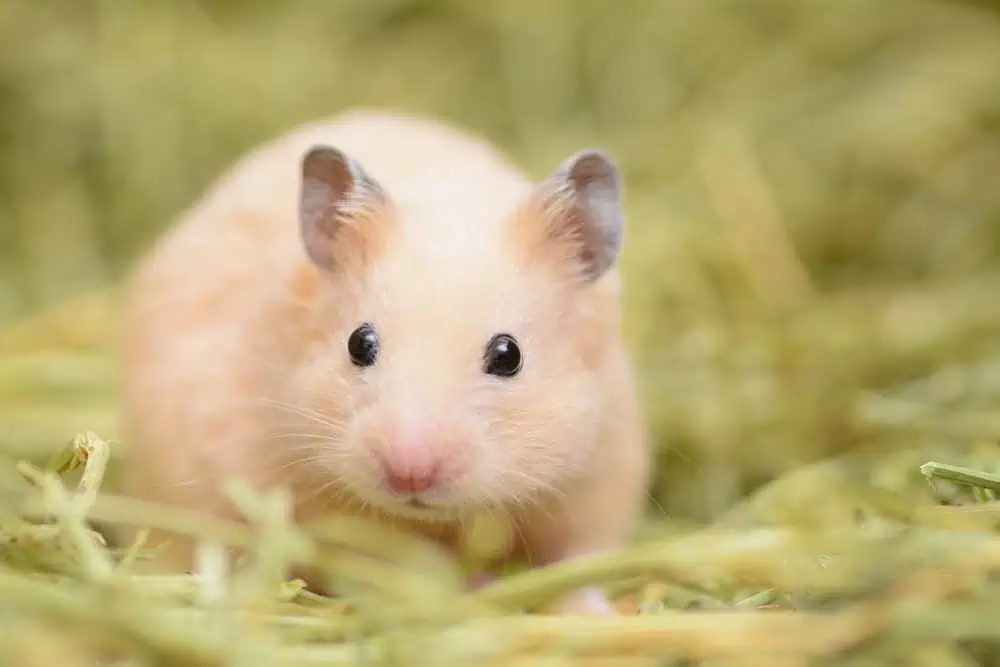
When hamsters emerge from their cosy sleeping quarters each evening, they like to get busy. Along with playing and exploring, hamsters will happily forage for hours, seeking out tasty morsels to nibble on, as well as hoarding food away in their amazing in-built storage system – their cheeks.
Native to the arid landscapes of Syria and Turkey, hamsters evolved their cheek pouches so they could take full advantage of food wherever it happens to turn up. As it's not always practical to eat what you’ve found right there and then – particularly if you’re at risk of becoming a hot lunch yourself if you hang around – it makes perfect sense to stuff it in your cheeks to take back to your burrow to eat it in safety. This is a natural behaviour that our pet hamsters continue to do.
DID YOU KNOW?
In the wild, hamsters are omnivores. They’ll happily munch on grasses, seeds, plant roots and the occasional tasty creepy-crawly and need protein in their diet to keep them healthy.
In fact, it’s this unique ability that got these characterful rodents their name. When biologist Israel Aharoni travelled to Turkey during the 1930s to study the species for the first time, he adapted the sound of the local Arabic dialect word for these little animals, coming up with ‘hamster’ – which translates to ‘mister saddlebags’.
DID YOU KNOW?
Hamster cheek pouches don't contain saliva glands, so everything is kept fresh and dry during transit.
Where’s it all gone?
While this cheek-stuffing behaviour is endearing, it does mean that it’s very easy to overfeed your hamster. The food you put out for them may quickly disappear – but the chances are they haven’t eaten it, they’ve simply hidden it away. As hamsters’ cheek pouches actually extend all the way down to their hips, they can store an amazing amount of food in them, so don’t be fooled by an empty dish.
That’s why it’s essential that you only feed your hamster with the amount of food they need each day – around a tablespoon of specially-formulated hamster nuggets each evening, depending on the species of hamster you have – which is your hamster’s breakfast time. Any more than that and you put your hamster at risk of getting tubby, which can lead to health problems.
Move away from muesli
Your choice of food is also important – nuggets are the best choice – steer away from ‘muesli-type’ mixtures as hamsters will pick out the bits that are high in sugar, which can cause painful problems with their teeth, and discard the parts that are high in fibre, which they need to stay healthy. Burgess nuggets prevent selective feeding and provide your pets with a balanced food that replicates their natural diet.
Treats to tempt
As a treat, you can also provide a tiny portion of hamster-safe, fresh veg a couple of times a week – such as broccoli, cauliflower, kale, cucumber, celery, parsley and basil. Always ensure any uneaten fresh food is cleaned away before it spoils.
Gnaw material
Hamsters also need some tasty hay to munch on, along with some untreated softwood such as hawthorn, hazelnut, pear, poplar or apple wood to chew. This will help keep their teeth healthy and stop them getting overgrown. Before you offer any softwood branches to your hamster to chew, give them a good clean and bake them on a low heat for an hour.
Scatter it about
You can put your hamster’s food in a gnaw-proof ceramic bowl, but scatter feeding is a great idea as it encourages natural foraging behaviours and your hamster will love rummaging around to find tasty titbits. This is also a good solution if you more than one hamster (as it’s only the Syrian or Golden hamster that likes lead a solitary life – find out more here) and one is very protective of the food bowl and won’t let his room-mates have their fair share.
Make feeding time fun time by hiding hay, hamster pellets or fresh greens inside paper bags or cardboard tubes. Not only is searching out food an enjoyable task, your hamster will also love shredding the packaging you hide it in, which all serves to enrich their life.
Water spout
Don’t forget to provide fresh water daily in a bottle specially designed for these tiny rodents, placed with the spout at the appropriate height for the type of hamster you have.
If you found this interesting, you may also like:
Create an ideal home for your hamster
Find out how to provide these small, smart rodents with the des res they deserve.
True or false? How well will you score in our fun hamster quiz?
Small and interesting, hamsters are one of the world’s most popular pets. But how much do you know about them and their fascinating hamster ways?
Life as a very small animal
Dwarf hamsters are undeniably cute, so it’s no wonder that they’re a very popular pet. Yet these tiny creatures, which are around half the size of a regular Golden or Syrian hamster, have very specific requirements to ensure they can enjoy happy hamster lives.
Sources: pfma.org.uk, pdsa.org.uk, petmd.com, thesprucepets.com, sciencealert.com














